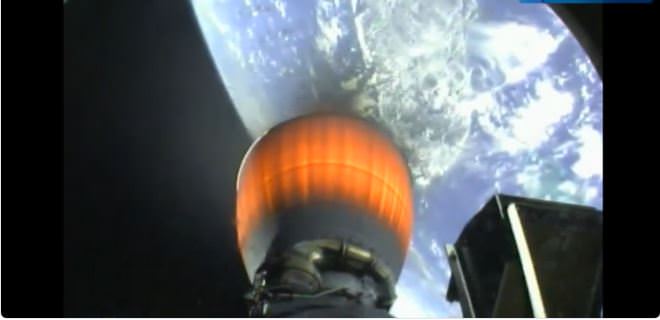SpaceX today released video from the Falcon 9 first stage flyback and landing video from the July 14 launch of six ORBCOMM advanced telecommunications satellites. This was a test of the reusability of the Falcon 9’s first stage and its flyback and landing system. It splashed down in the Atlantic Ocean, and SpaceX called it a “soft” landing, even though the booster did not survive the splashdown. SpaceX CEO Elon Musk tweeted on July 14 that the rocket booster reentry, landing burn and leg deployment worked well, but the hull of the first stage “lost integrity right after splashdown (aka kaboom).” He later reported that detailed review of rocket telemetry showed the booster took a “body slam, maybe from a self-generated wave.”
SpaceX today said last week’s test “confirms that the Falcon 9 booster is able consistently to reenter from space at hypersonic velocity, restart main engines twice, deploy landing legs and touch down at near zero velocity.”
This video is of much higher quality than the video from the first soft landing test in the ocean, back in April of this year following the launch of the CRS-3 mission for the Dragon spacecraft to the International Space Station.
Even though the booster has not been recoverable from either test (the April test saw too rough of seas to get the booster) SpaceX said that they received all the necessary data “to achieve a successful landing on a future flight. Going forward, we are taking steps to minimize the build up of ice and spots on the camera housing in order to gather improved video on future launches.
The booster tipping over is the nominal procedure (in water), but the booster did touch down in a vertical position; additionally, as seen in the video, the landing legs deployed perfectly, and the flyback boosters performed flawlessly.
“At this point, we are highly confident of being able to land successfully on a floating launch pad or back at the launch site and refly the rocket with no required refurbishment,” SpaceX said in today’s press release. “However, our next couple launches are for very high velocity geostationary satellite missions, which don’t allow enough residual propellant for landing. In the longer term, missions like that will fly on Falcon Heavy, but until then Falcon 9 will need to fly in expendable mode.”
The next attempt for a our next water landing will be on Falcon 9’s thirteenth flight, a launch to the ISS for the fourth resupply mission, but they indicated the test would have a “low probability of success.” That flight is currently scheduled for no earlier than September 12, 2014. The next big challenge comes in flights 14 (another ORBCOMM satellite launch) and 15 (Turkmen satellite), where the booster will attempt to land on a solid surface. Those flights are currently scheduled for NET October and November of 2014.


Inch by inch, step by step… closer and closer! This is the first I’ve heard of using this technique for landing on an off shore platform. This makes perfect sense – Fewer grass fires anyway! Are you listening Sea Launch?
“but the booster did touch down in a nearly horizontal position”
I hope you meant to type “vertical”…
Pretty sure she did, yeah:). Either that or SpaceX has some… “revolutionary” ideas about how to safely land a rocket.
Oh my! Yes, I meant to type vertical…. fixed now, thanks!
Do you read all the comments to your blogs? Being Senior Editor, do you read all the comments posted at UT? If so, UR a busy girl!
Straight up and down, just like God and Robert Heinlein intended.
Absolutely!
This steady progress is so encouraging, I can’t wait to see a soft touchdown on land/platform. It will be a game changer.
SpaceX might have some trouble to recover their rockets until they launch from Texas so they can land in Florida. They don’t really have the choice since they need to lunch the closest possible to the equator for maximum efficiency. Also, launching over inhabited area isn’t safe at all.
What a shame SpaceX had to build their spaceport in such a retard anti-science state. They seriously don’t deserve it.
From the above, it looks like they are looking into offshore platform landings. Sea Launch has shown how to launch from such a platform after sailing to the equator. Landings present other challenges of course, especially how to deal with the heat generated by the rockets.
The F9 flies all the way back to the launch pad; it’s not that far downrange. Launching from Texas and landing in FL does not give them the low cost next launch capability Musk targets and the large distance to FL would require more fuel than returning to site. If SX ever succeeds in far, far more difficult 2nd stage recovery, launch TX and recover FL might be in the cards.
Texas deserves all the business it gets with its job friendly environment.
Trick is to punch through the thickest part of the atmosphere in a nearly vertical flight envelope or at least as much as is practical within mission constraintts, then provide powered flight back to the launch/landing platform to refuel and fly again on the same day with the same booster. Yes!
The second stage booster its the way the vehicle achieves orbital velocity…
The problem with having downrange land-masses is that they often have people living on them, and sometimes rockets fail and crash downrange…
Landing on an unmanned floating platform (a barge) sounds like a good idea, although it would add a new constraint to launching: The sea conditions would need to be good so that the platform does not pitch and roll too much.
Floating platform sounds like an ideal solution. The New SpaceX Boca Chica site they are currently building seems to have waterways and docks for vessel porting and unloading.
I expect a land launch and a ship landing to be announced as the new way to go.